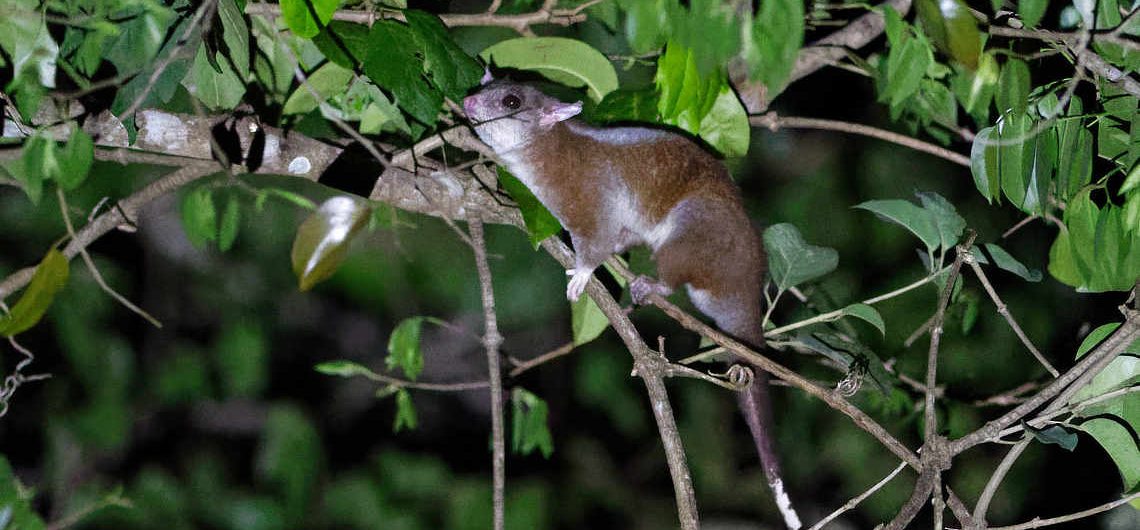Central American Woolly Opossum
Caluromys derbianus
The Central American Woolly Opossum is a medium-sized marsupial of the rainforests of Central America and northwestern South America. In comparison to other opossums, it is rather cute, with a thick coat of fur, gray in color with extensive reddish or brownish patches and creamy white underparts. It has large, pinkish ears, large brown eyes that give off a bright red eyeshine, and a stripe on its gray face that runs from its forehead down toward its nose. The Central American Woolly Opossum has a very long prehensile tail (longer than its body length), distinctly furred at the base for half its length, then naked to the tip. The midsection of the tail is mottled dark brown with white, and the tip is completely white. The white tip of the tail and pinkish ears distinguish this species from other opossums. Its body length is 22 to 30 cm, and its tail is 38 to 45 cm, giving an overall length of 60 to 70 cm, and it weighs 245-370 grams. Also known as Derby’s Woolly Opossum, it is the largest of its genus (three species of woolly opossums), and has six recognized subspecies. The members of this genus also have the largest brain size of all the opossums.
The Central American Woolly Opossum is primarily found in Central America, ranging from Mexico to western Colombia and Ecuador. It is found in the lowlands up to the lower highlands, from sea level to 2500 m elevation. Uncommon to locally common, the Central American Woolly Opossum lives in primary and secondary growth forests, and frequents forest edges and dense vine tangles. Central American Woolly Opossums are strictly nocturnal, active well after dark and during the darkest parts of the night. They are completely arboreal, rarely venturing down to the ground, and are fast runners, moving quickly along tree branches and from tree to tree. They use their prehensile tail for grasping branches and assisting with balance during their arboreal pursuits. They have very sharp vision, and their prominent, forward-facing eyes give them binocular vision – they have well-developed depth perception and excellent hand-eye coordination, an important adaptation for arboreal mammals. Their diet consists of insects, fruits, nectar and sometimes small vertebrates. The Central American Woolly Opossum’s diet is varied seasonally depending on the availability of foods – in the dry season, they feed on nectar, taking on an important role of pollinator for the trees. Likewise, when consuming fruit, they are efficient seed dispersers – the seeds are eaten and pass through their gut unharmed, being displaced and fertilized in another location. Central American Woolly Opossums are solitary, and roost during the day in nests made up of leaves in dense vine tangles. They have small home ranges in comparison to other mammals their size, usually staying within a single square kilometer. Several island populations are reportedly diurnal. Ocelots are known predators of Central American Woolly Opossums.
Like all other opossums, the Central American Woolly Opossum is a marsupial. Litter size is typically between 1 and 6 young. The gestation period is short, and when the “joeys” are born, they are rather underdeveloped. They climb unassisted to their mother’s pouch and attach themselves to her nipples where they remain for up to a couple months while they continue to grow. After this point the young slowly wean, and become independent around 120 days of age. Females only have a pouch when carrying young; when not breeding, the pouch regresses to small folds. Young are slightly grayer in color than adults. Central American Woolly Opossums are sexually mature by 7 to 9 months of age, and are short-lived overall; many don’t survive longer than a breeding season. In Panama, they breed during the dry season from January to April, but are known to breed year-round in other parts of their range. The Neotropical marsupials are generally polygynous.
Locally common in some parts of its range, the Central American Woolly Opossum is classified as a Species of Least Concern by the IUCN. However, populations in Mexico and Ecuador are declining due to deforestation and habitat loss. This species used to be hunted for its fur, but that is no longer in demand.
Central American Woolly Opossums can be seen feeding in the cecropia trees around the Canopy Tower after dark, and on the grounds of the Canopy Lodge and Canopy Camp. In Panama, the Central American Woolly Opossum is locally known as “comadreja.”

